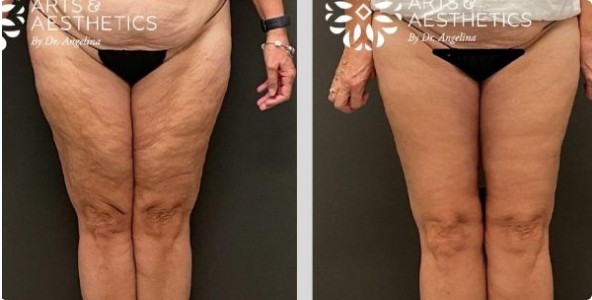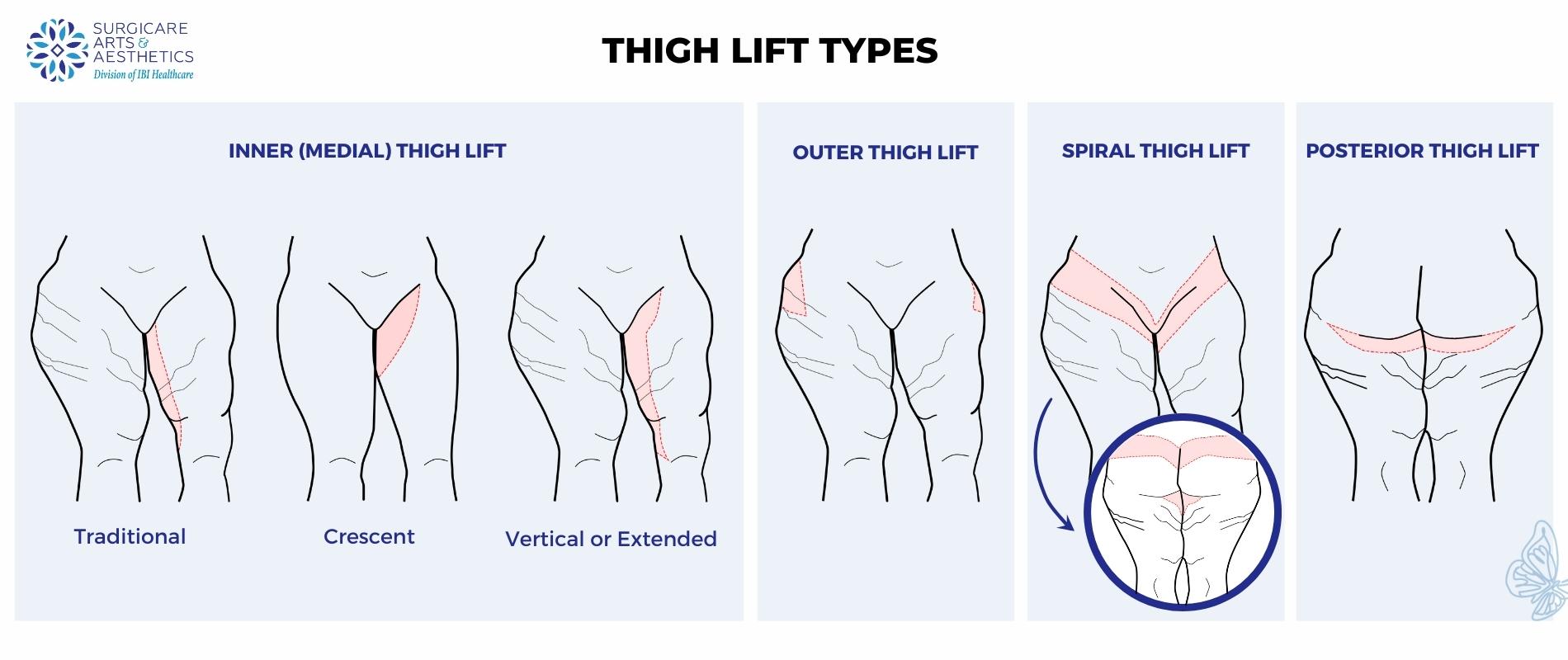Today, individuals have the opportunity to pursue their aesthetic goals and use a combination of their own efforts and the magic of cosmetic surgery to achieve a more contoured and proportionate physique.
Breast augmentation has been one of the most popular forms of cosmetic surgery for many years; however, thigh lift surgery has gained significant popularity over the years and has now become one of the most sought-after procedures in the country. Actually, the number of thigh lift procedures has nearly quadrupled since 2007, thanks to the success of bariatric surgeries. After losing a significant amount of weight, many individuals may consider undergoing surgery to address the issue of sagging and lumpy skin that often remains.
Today we are going to talk about the medial thigh lift, which is one of a few surgical techniques used to address cosmetic or physical concerns related to the thighs. We will discuss the benefits of a medial thigh lift as well as the differences between traditional and extended medial thigh lift procedures and factors that influence the associated costs.
What Is A Medial Thigh Lift?
The medial thigh lift is a surgical procedure aimed at improving the appearance or addressing physical concerns related to the inner thighs by eliminating excessive sagging skin and excess tissue. Also known as an inner thigh lift, this procedure is ideal for individuals who have experienced significant weight loss and are left with a large amount of sagging excess skin, or it would also be beneficial for individuals with loose, hanging skin due to aging or genetic factors.
The medial thigh lift restores contour and tone to the upper thighs, and aside from creating a more contoured and aesthetically pleasing thigh area, it can also alleviate many areas of medical concern.
What Problems Can Loose Sagging Skin On The Thighs Cause?
Excess skin hanging down on the thighs can cause various physical problems and discomfort. These issues can affect an individual’s quality of life and may require medical attention or surgical intervention. Some of the common physical problems associated with excess skin on the thighs include:
- Extra skin can rub against other skin surfaces or clothing, which might cause chafing and skin irritation. This may lead to discomfort, redness, and, in severe cases, even open sores;
- Skin folds can trap moisture and sweat, which can create an environment for bacterial and fungal growth. It can be a bit tricky to keep up with good hygiene in these areas, which could raise the chances of getting skin infections;
- Having a lot of droopy or saggy skin makes it harder to move around and do everyday activities. This circumstance might also affect your performance at work and your personal and family lives.
- Carrying a large amount of skin on your thighs might increase the risk of being exposed to a health condition named intertrigo which can be treated medically only. When you walk or run, your skin rubs together. Intertrigo happens when there is too much skin friction which leads to redness, inflammation, rashes, and breakdown of the skin.
- With excess skin, you might also struggle to find the right size of clothing which can affect your self-image, diminish your self-confidence, and cause emotional distress.
- In light of these challenges, you might simply have no energy or motivation to keep working on your weight loss. Since weight loss is never an easy journey, people with such issues can get stuck before they reach their dream goals.
What Does The Medial Thigh Lift Procedure Involve?
Although the exact procedure can vary by surgeon, the following is a general overview of medial thigh lift surgery.
- A medial thigh lift surgery begins with the administration of anesthesia to ensure the patient’s comfort and safety during the procedure. The type of anesthesia used may vary, and your surgeon will discuss the best option for you based on your medical history and preferences;
- The surgeon will strive to make discreet incisions in the natural creases of the groin area, allowing for minimal visibility of scarring; however, the length and location of the incisions may vary depending on the extent of the correction required;
- Next, excess skin and fat are carefully removed from the inner thigh area through these incisions. The remaining tissue is then skillfully reshaped and tightened to achieve a smoother and more contoured appearance;
- Once the excess tissue and skin have been successfully removed, the incisions are carefully closed using several layers of strategically placed sutures; (Often, surgeons use absorbable sutures to minimize the need for suture removal)
- After completion of the surgery, patients are taken to a recovery area where they are closely monitored as they awaken from anesthesia;
- You may need to spend the night in the hospital or may be discharged to go home depending on the extent of your surgery. Instructions for post-operative care, the use of special compression garments, and activity limitations will be provided by your surgeon to ensure proper healing and recovery. You will also be provided with a date for a follow-up appointment with your surgeon, which usually falls between 10 days and two weeks. Most patients recover in four to six weeks.
Traditional Medial Thigh Lift vs Extended Medial Thigh Lift
The primary difference between a traditional medial thigh lift and an extended medial thigh lift is the extent of tissue removal and the length of the incision necessary to achieve the desired result.
- Medial Thigh Lift
- A traditional medial thigh lift focuses on addressing moderate to mild sagging and excess skin on the inner thighs. The incision is usually limited to the groin area, and the procedure is most suitable for patients with less excess skin to address.
-

Medial thigh lift before and after - Extended Medial Thigh Lift
- The extended medial thigh lift is more extensive and works well for patients with significant skin laxity and excess tissue that extends to their outer thighs. The incision is typically made from the groin to the back of the thigh, allowing for more extensive skin and tissue removal.
How Much Is The Cost Of A Medial Thigh Lift?
The cost of a medial thigh lift can vary depending on various factors, including the geographic location of the surgical facility, the expertise, and credentials of your chosen surgeon, the fees charged by the surgical facility or hospital, the expenses related to the administration of anesthesia, the extent and complexity of the surgery (the type of thigh lift performed), post-operative care (costs associated with compression garments, follow up appointments, etc.).
According to recent statistics from the American Society of Plastic Surgeons, the average starting cost of thigh lift surgery is around $5,355. It is important to ensure you understand what your surgical quote includes and what your total financial obligation will be. Some cosmetic surgeons may offer all-inclusive pricing while others may quote a base price with additional fees added to it.
Contact IBI Plastic Surgery & Med Spa To Learn More About A Medial Thigh Lift
If you are embarrassed by excess skin sagging and hanging from your thighs, set up a consultation with IBI Plastic Surgery & Med Spa. Many patients have traveled great distances to experience the expertise of Dr. Angelina Postoev, a triple board-certified cosmetic surgeon and one of the nation’s only certified thighplasty experts.
A medial thigh lift may be a great choice for you if you are seeking to address sagging skin and excess tissue on your inner thighs. Dr. Angelina is an expert in both traditional and extended medial thigh lifts and will discuss which procedure may be the best one for you depending on your unique needs and aesthetic goals.
Additionally, IBI Plastic Surgery & Med Spa offers cosmetic procedures that can address minimal amounts of sagging skin located on your inner thighs without the need for surgery. Contact us today and find out how we can enhance the contours of your thighs and give them a more toned and youthful appearance.









